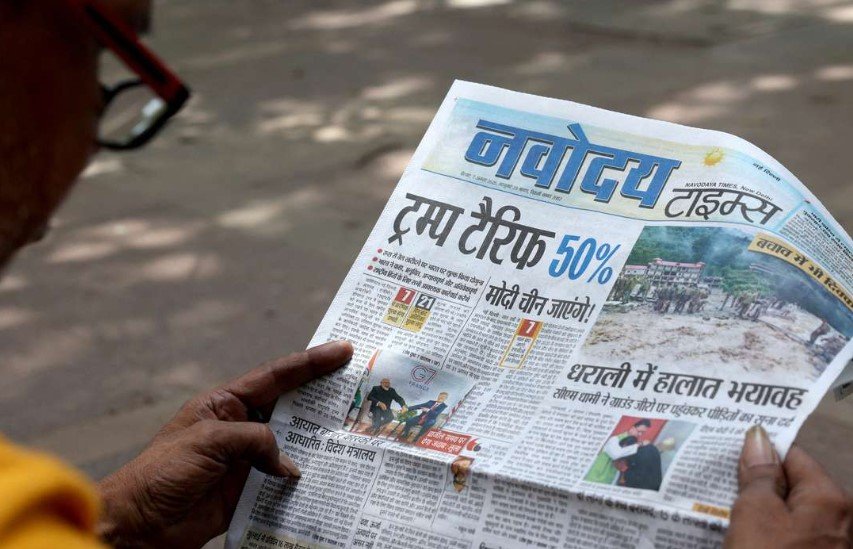A sudden surge of anger is gripping India’s consumer market after U.S. President Donald Trump slapped a steep 50% tariff on Indian goods. From social media hashtags to street-level protests, American companies are finding themselves in the crosshairs of public sentiment.
Big Tariffs, Bigger Outrage
The tariff decision hit like a thunderclap. Announced with Trump’s usual flair, the measure has rattled exporters and pushed an already delicate trade relationship with India into choppier waters.
What’s unusual this time isn’t just the political wrangling — it’s the consumer reaction. Calls to boycott American products are spreading fast, fueled by pro-government voices and nationalist influencers. And the message is simple: buy Indian, not American.
There’s no confirmed slump in sales yet, but the tone in marketplaces, both real and virtual, is shifting. Every mention of “50% tariffs” is now accompanied by a pointed jab at brands like Apple, Amazon, McDonald’s, and Coca-Cola.
America’s Biggest Names Suddenly on the Defensive
India isn’t just another market for American multinationals — it’s one of their biggest growth bets. Apple recently opened flagship stores in Mumbai and Delhi to much fanfare. Amazon has poured billions into its Indian operations. Starbucks offers India-exclusive beverages to woo local tastes. And then there’s Domino’s, which has more outlets in India than in any other country.

Now, those same brands are caught in a political squall they didn’t start. Industry insiders say some companies are quietly drawing up contingency plans in case the boycott sentiment grows teeth.
One brand consultant in Mumbai described the risk bluntly: “It’s not about whether people stop buying your product tomorrow — it’s about the shift in narrative. Once you’re seen as ‘American’ during a trade fight, you become a symbol.”
How ‘Buy Local’ Went Viral
The push to shun U.S. goods isn’t new in India — but it’s rarely gained this kind of momentum so quickly. Within hours of the tariff announcement, hashtags like #BoycottAmericanGoods and #SelfReliantIndia trended on X (formerly Twitter) and Instagram. Memes mocked “overpriced coffee” and “foreign fast food,” while others shared long lists of homegrown alternatives.
Some posts were more emotional than economic. Photos of Indian farmers, factory workers, and small shopkeepers were paired with captions urging people to support domestic producers over “companies that don’t respect India’s trade.”
Offline, shopkeepers in a few cities have put up signs declaring “American products not sold here” — though many admit it’s more symbolic than a practical shift in inventory just yet.
What’s at Stake for the US Corporate Giants
The stakes are enormous. India is the largest market for Meta’s WhatsApp, with over 500 million active users. Coca-Cola and Pepsi control most of the country’s soft drink market. Amazon has over 100 million Prime subscribers in India. If boycott calls gather steam, even a small dip in market share could mean big losses in absolute numbers.
Here’s a quick look at how some U.S. giants are positioned in India and what’s on the line:
| Company | Indian Market Footprint | Risk Exposure if Boycott Gains Ground |
|---|---|---|
| Apple | Flagship stores + growing iPhone sales | High, as premium sales depend on urban consumers |
| Amazon | Billions invested in logistics and retail | Very High, core e-commerce platform |
| Domino’s | Over 1,800 outlets nationwide | High, heavy dependence on everyday orders |
| Coca-Cola | Strong distribution network in urban & rural areas | Moderate to High, given brand visibility |
| Starbucks | Over 400 stores with expansion plans | High, positioned as aspirational brand |
One trade lobbyist told me companies are quietly pressing Washington to rethink the tariff move, arguing that “India is not just another export market — it’s the future.”
The Government’s Calculated Silence
Interestingly, the Modi administration hasn’t officially called for a boycott — but it hasn’t exactly discouraged it either. Ministers have publicly condemned the tariffs, and state-run broadcasters have given airtime to voices urging consumers to “go local.”
This ambiguity keeps the government’s diplomatic options open while letting public sentiment apply pressure in its own way. For some in New Delhi, the swelling boycott chatter is a useful tool — a reminder to Washington that economic moves carry political consequences in one of the world’s largest democracies.
Still, officials are keeping the trade negotiation table open. Talks, which began back in February, continue in parallel to the tariff war. Whether they produce any breakthrough before the festive season shopping spree begins is another matter entirely.
Will It Fizzle or Fire Up?
Boycotts in India have a mixed record. Some vanish within weeks once the initial outrage fades. Others — like the long-standing preference for local dairy brands over foreign ones in certain states — leave permanent marks on consumer behavior.
The difference this time could be timing. The tariff blow lands just ahead of India’s festival-heavy shopping calendar, when spending spikes and brand loyalties are tested. If the “buy local” message sticks through Diwali and into the new year, American brands might find themselves scrambling to repair their image in 2026.
For now, the fight is as much about perception as it is about sales numbers. And in a market of 1.4 billion people, perception can change a lot more than just quarterly earnings.
